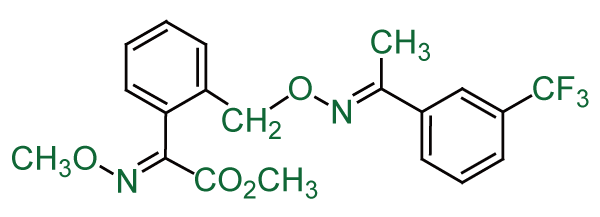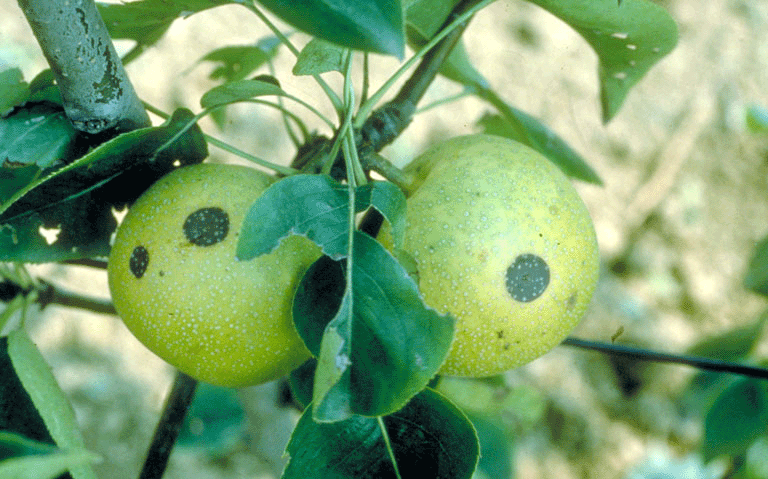- Azoxystrobin
- Bitertanol
- Captan
- Carboxin
- Carbendazim
- Cymoxanil
- Cuprous Oxide
- Copper Hydroxide
- Cyproconazole
- Cyprodinil
- Dimethomorph
- Diniconazole
- Difenoconazole
- Epoxiconazole
- Fluazinam
- Fludioxonil
- Fosetyl-aluminium
- Hexaconazole
- Imazalil
- Iprodione
- Kasugamycin
- Mancozeb
- Metalaxyl
- Metalaxyl-M
- Penconazole
- Propiconazole
- Prochloraz
- Propineb
- Pyraclostrobin
- Thiophanate-methyl
- Tebuconazole
- Tetraconazole
- Tricyclazole
- Triadimenol
- Triadimefon
- Tridemorph
- Trifloxystrobin
Trifloxystrobin
other name: (E,E)-(methoxyimino)2-[[[[1-[3(trifluoromethyl) phenyl]ethylidene]amino]oxy]methyl]-benzeneacetic acid methyl ester
 CAS No.: [141517-21-7]
CAS No.: [141517-21-7]
Molecular Formula: C20H19F3N2O4
Trifloxystrobin is a new broad spectrum fungicide. It is a synthetic derivative of the naturally occurring strobilurins found in several genera of wood decaying fungi. The mode of action of trifloxystrobin involves inhibition of mitochondrial respiration by blocking electron transfer in the electron transfer chain. The fungicidal properties of trifloxystrobin are derived from the parent ester; the acid form (the main metabolite) is inactive.
Trifloxystrobin is used for the control of black spot on apples and pears, powdery mildew on apples and the control of powdery mildew and suppression of downy mildew on grapes
Trifloxystrobin is applied to foliage and is strongly adsorbed to the waxy, cuticular layer of plants. Product that remains on the leaf surface acts as a protectant. Some product penetrates the cuticle and remains either just below the surface to provide curative activity or is distributed locally providing translaminar activity. However, it is not translocated in the vascular system.
It is safe to crops and shows no cross-resistance to fungicides from other chemical classes. The product has a greening effect on cereals that leads to increased yields.
It is recommended that trifloxystrobin is used primarily in a preventative spray schedule.
Trifloxystrobin also has activity via movement in the vapour phase, which contributes to disease control within the crop canopy.
APPLICATIONS 
Biochemistry
Inhibits mitochondrial respiration by blocking electron transfer at the Qo centre of cytochrome bc1.
Mode of action
Mesostemic, broad-spectrum fungicide with preventative and specific curative activity and displaying rain-fastness. Redistributed by superficial vapour movement and also has translaminar activity.
Uses Broad spectrum fungicide for foliar use on a wide range of agricultural and horticultural crops in temperate, sub-tropical and tropical climates in open fields or protected under glass and plastic. In Europe its uses will be focussed on cereals (at 50 g/ha), grapes (at 187.5 g/ha), pome fruit (at 75 g/ha), and cucurbit crops (at 187.5 g/ha).Trifloxystrobin is active against fungi in all four classes - Ascomycetes, Deuteromycetes, Basidiomycetes and Oomycetes.
Formulation types EC; SC; WG.
Our Technical Material (TC) have the specification as below:
| Items | Specification |
| Appearance | Offwhite powder, |
| Content | 95% min. |
| Loss of drying | 0.5% max. |
GHS complaint Safety Data Sheet (SDS) for commercial product of Trifloxystrobin is available uopn requested.
